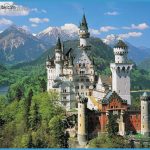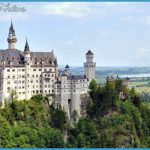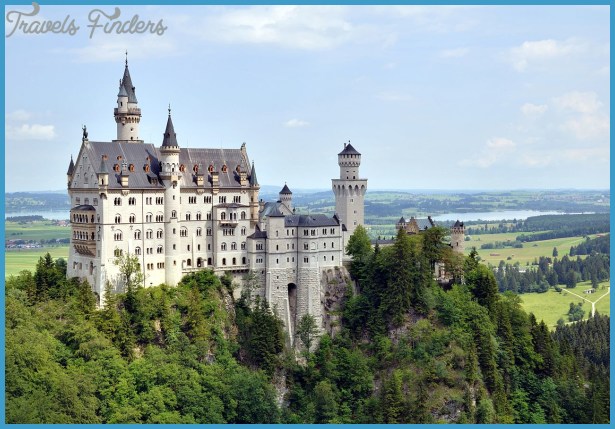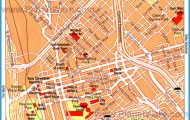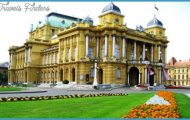EDUARD RIEDEL
High on a crag near the village of Hohenschwangau in southwest Bavaria lies the fairy-tale castle of Neuschwanstein. It was built in the late 19th century for King Ludwig II of Bavaria, who had been inspired by visits to two ancient castles-the Wartburg in Germany and Pierrefonds in France-both reconstructed in the medieval style with massive walls, tall towers, and battlements, but furnished with palatial interiors. Ludwig was obsessed by medieval history and the operas of Richard Wagner-dramatic sagas of gods, heroes, and knights-and wanted a mock-medieval castle with interiors that reflected a bygone age of chivalry. The king’s architect, Eduard Riedel, may have based his work on that of stage designer Christian Jank to create the ultimate romantic castle.
The Romanesque-revival style chosen by Riedel was popular in Germany, where many architects considered its round-topped arches, barrel vaults, and sturdy walls to be essentially Germanic in character, in contrast to the more delicate Gothic Revival style with pointed arches, which they associated with the French. The version of Romanesque used by Riedel is fanciful: there are none of the fortifications of a true castle, but every feature of the building-towers, turrets, and the way the structure seems to rise organically out of the hill-is designed to recreate the image of an “ideal castle. The towers and turrets, for example, were included solely for dramatic effect.
Ludwig worked closely with Riedel and influenced the design of the exterior as well as that of the interior, with its wall paintings of mythical scenes and the precise positions of decorative details. Although the fruit of one man’s very personal vision, the building encapsulates many people’s idea of the ultimate fairy-tale castle.
LUDWIG II
c. 1845-86
Ludwig II became king of Bavaria in 1864, when he was 18. He was unprepared for rule and suffered a major blow when Prussia conquered Bavaria in 1866, bringing Ludwig under the control of his uncle, Wilhelm I of Prussia. As a result Ludwig had little real power, and he put his energy into creating a fantasy world, building elaborate residences including Herreninsel and Neuschwanstein. Here he could imitate the life of the kings and knights of the Holy Grail legends, becoming more of a recluse in the process. His building projects were also hugely expensive, and Ludwig spent his vast private fortune before taking on loans from foreign banks. When he refused to pay them back, the banks threatened to seize his assets. The Bavarian government declared him insane and imprisoned him. He drowned under mysterious circumstances in Lake Starnberg, near Castle Berg, where he was held.
Visual tour
4 TOWER This is a good example of how the architect added features to the castle purely to enhance the visual effect. Medieval castles often feature overhanging battlements with machicolations holes in the overhang for dropping missiles on attackers. The towers at Neuschwanstein have these overhangs and battlements with beautifully carved masonry but not the defensive features.
2 GATEHOUSE In a medieval castle the main purpose of the gatehouse was to provide an entrance that could be securely barred against enemies. The purpose of the gatehouse at Neuschwanstein was to look impressive and provide a ceremonial gateway for visitors, a fitting prelude to the courtyard and the lavish apartments inside. Riedel therefore added features such as the royal coat of arms, the bartizans (small projecting corner turrets), plus a stepped gable to give extra height. These features evoke the military history of real castles, while also creating an interesting and impressive skyline that looms above visitors as they pass through the gate.
The buttresses provide extra support where the castle walls rise above the crag
3 THRONE ROOM With its rows of arches and apse at the end the design of the throne hall was based on the interior of a church in Munich, with Ludwig’s throne occupying the position of the high altar. The walls are decorated with paintings of Jesus Christ, the Apostles, and kings who had been canonized subject matter that reminded visitors that medieval kings ruled by divine right and with the support of the Church. Ludwig, as a constitutional monarch with limited powers, had no such support.
4 PALAS Rising tall at one end of the courtyard, the residential block (Palas in German) contains the royal apartments and state rooms on the upper floors and servants’ rooms below. The shape of the turrets on this building was influenced by those at the Chateau de Pierrefonds in France. The lower building to the right is called the Knights’ House. The name alluded to the age of chivalry, but in reality Neuschwanstein’s offices and service rooms were located here.
Conical roofs with tall finials add interest to the skyline
4 SINGERS’ HALL This large room is based on two rooms (the Festival Hall and Singers’ Hall) in the Wartburg, a great castle near Eisenach, Germany. The Wartburg was said to be the location of a singing contest between medieval minstrels a key scene in Wagner’s opera Tannhauser. The murals in the Hall depict the story of Parsifal and the Holy Grail, another legend that obsessed Ludwig. The entire room is a memorial to the mythical knights who sought the Holy Grail.
The main courtyard provides circulation space and an approach to the castle’s main buildings
ON DESIGN
The gatehouse is the only part of the castle not totally clad in white stone
2 ROYAL BEDROOM
This room is covered in wooden paneling, and the bed has a Gothic-style wooden canopy and coverings embroidered with symbols that were personal to Ludwig, including swans, lilies, and the Bavarian coat of arms. The furnishings include elaborately carved chairs and a washstand that incorporates a fountain in the shape of a silver-plated swan. Above the wall paneling is a sequence of paintings depicting the story of Tristan and Isolde, the doomed lovers of medieval legend and the protagonists of Tristan and Isolde, one of Wagner’s greatest operas.
Richard Wagner, the composer who inspired Ludwig to build his castle, wanted his operas to be total works of art in which music, words, costumes, sets, and other elements came together to produce an overwhelming experience. Ludwig aimed for a similar effect architecturally, bringing together his architect and painters, carvers, metalworkers, and other artists to create his own version of a medieval castle, where he could withdraw from the problems of everyday life. Numerous characters from Wagner’s operas appear in the works of art in the castle, but it was Parsifal’s son Lohengrin, a knight and protector of those in need, with whom Ludwig identified closely. Lohengrin traveled in a boat drawn by a swan, and this inspired the many images of swans in the castle.
1 Stained glass
Swan imagery appears in this castle in many forms, including this stained-glass window.

